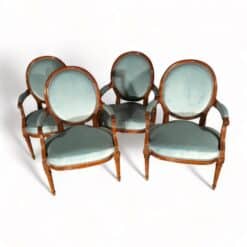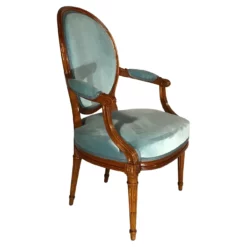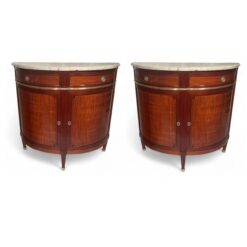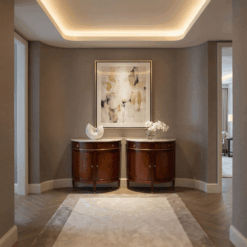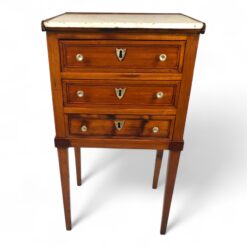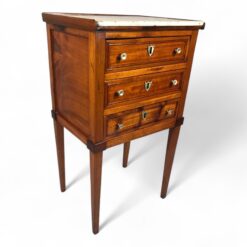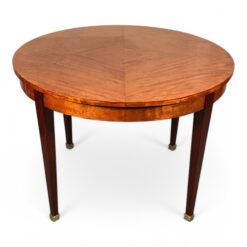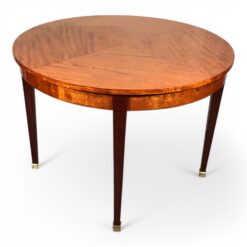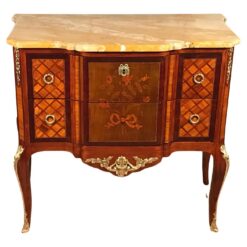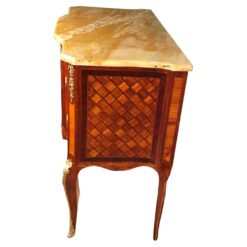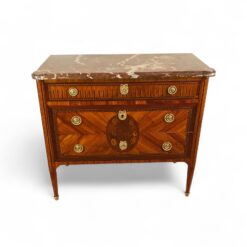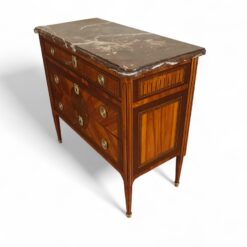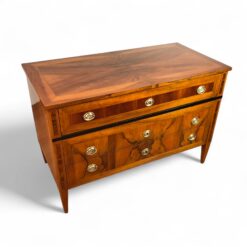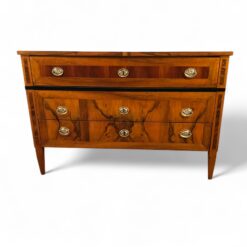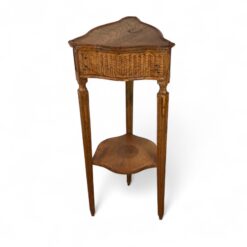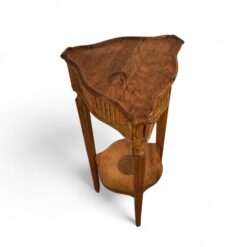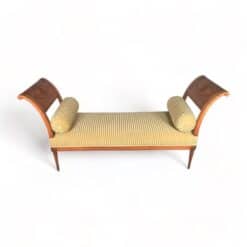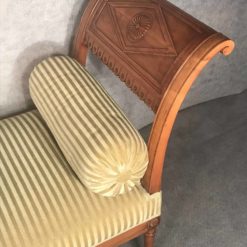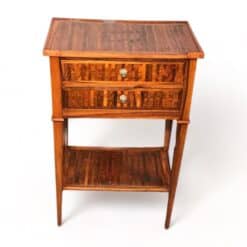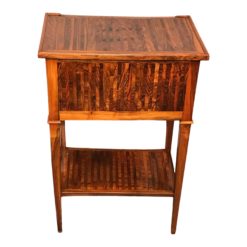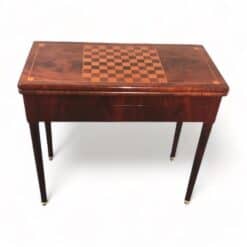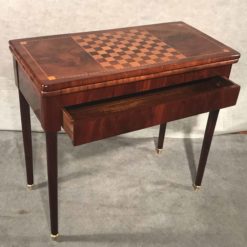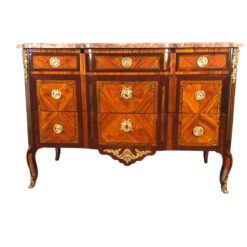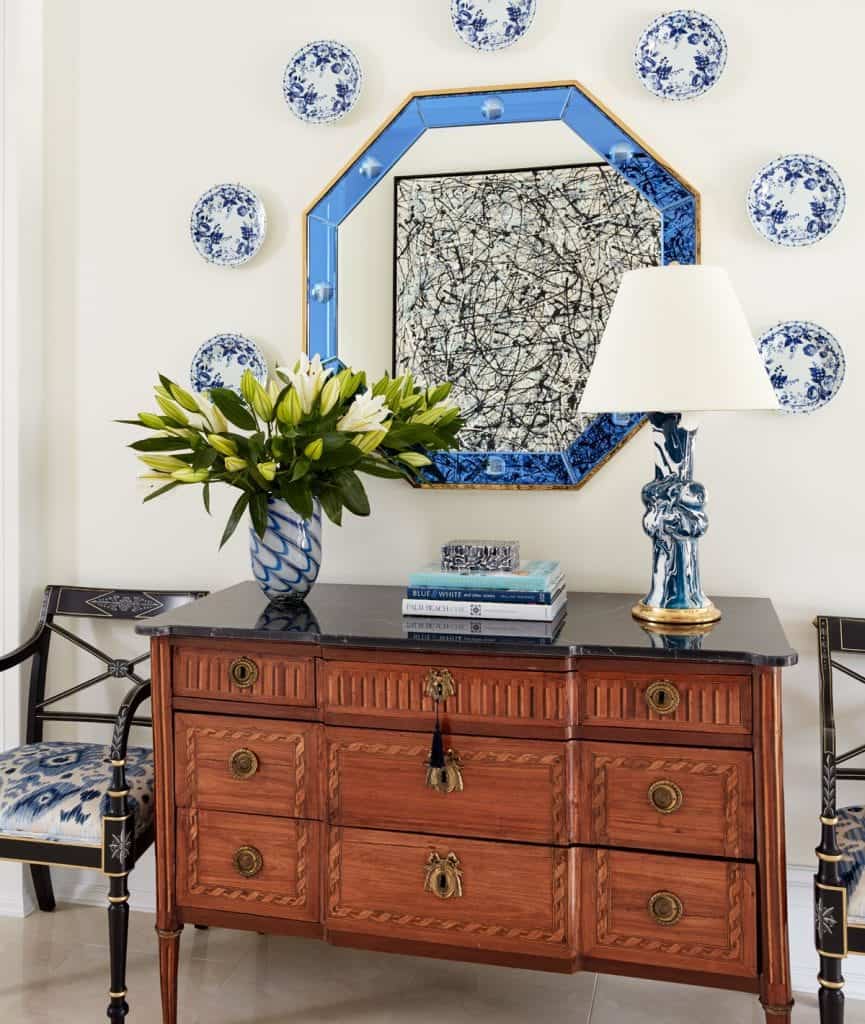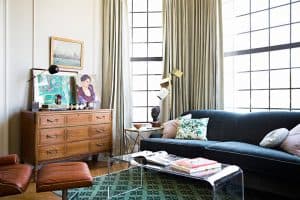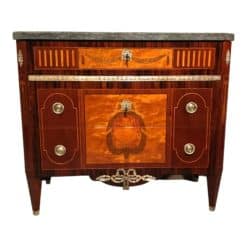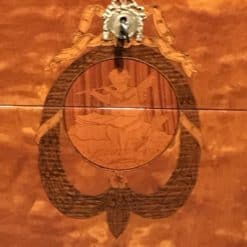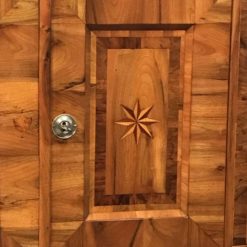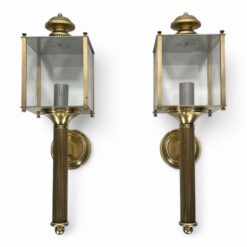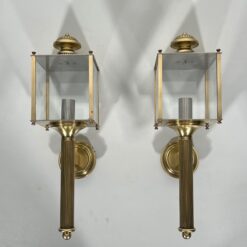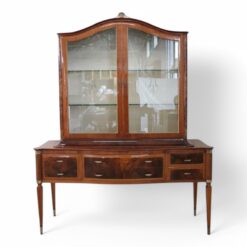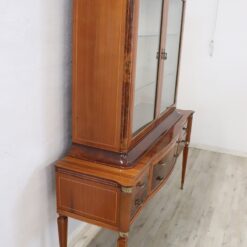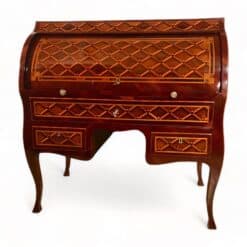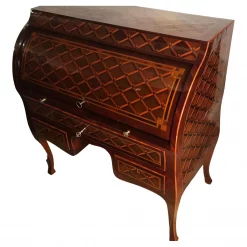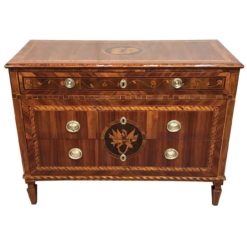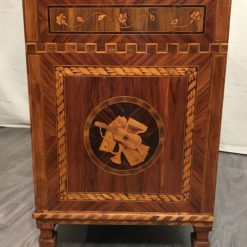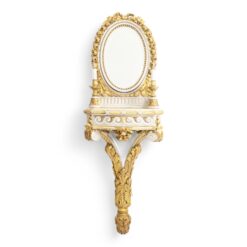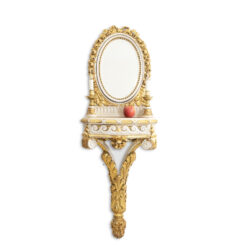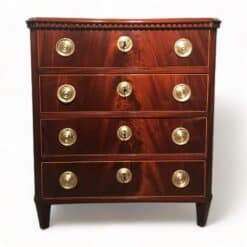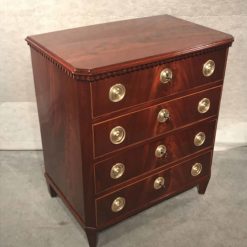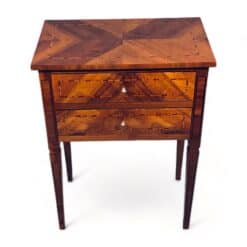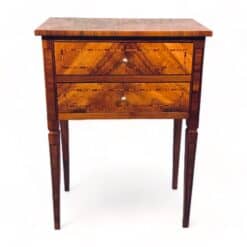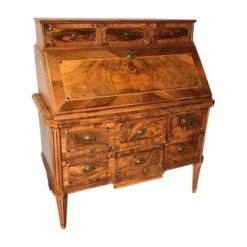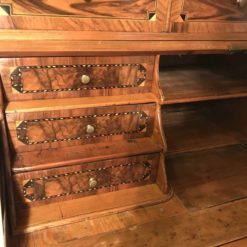Best Sellers
Furniture, How-To & Inspiration, Styylish History
Louis XVI Furniture Styles: Styylish Spotlight
Louis XVI furniture styles are some of our favorite pieces here at Styylish. In this guide, you’ll find everything from history to design tips, along with a buying guide of selected pieces.
The History of Louis XVI Furniture
The Louis XVI period began circa 1750, slightly prior to the reign of King Louis XVI (“Louis The Last” 1774–1793), and continued until the French Revolution and turn of the 19th century. Here we find the final manifestation of the Baroque style, in addition to the genesis of French Neoclassicism.
Also known as the “goût grec,” the Louis XVI style sees pieces characterized by elegance, along with a harkening back to stylized designs and motifs from the Hellenic period, due to the plethora of ancient Greco-Roman works discovered via archaeological digs at the time. Discoveries at Herculaneum and Pompeii were particularly influential. The Louis XVI period also featured a reaction against the florid stylings found in the previous era. Restrained, geometrical forms made a resurgence, as opposed to the twirling, freehand designs of the Rococo period.
Marie Antoinette
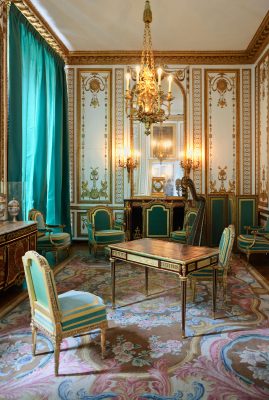
Much of the Louis XVI French furniture was designed and crafted specifically for Queen Marie Antoinette. Its purpose was to furnish many of the apartments she created in the palaces at Versailles, Fontainebleau, and Tuileries, among numerous other royal halls and residences.
Although Louis XVI himself had scant interest in the arts, his wife, Marie-Antoinette, along with her family, were major patrons of the arts. They commissioned large quantities of neoclassical furniture. gave their protection to artists, and ordered large amounts of furniture in the neoclassical style, inspired by Greco-Roman art. This led to numerous wealthy nobles copying their taste, subsequently furnishing their chateaux and townhomes in the novel style as well.
The transition from the Baroque and the Rocaille style to the Neoclassical in France began close to 1760, at the end of Louis XV’s reign (and the Louis XV style).
Unearthing the Neoclassical
After the aforementioned digs at Herculaneum and Pompeii, Madame de Pompadour, Louis XV’s chief mistress, sent a number of scholars to Italy to report back on the findings.
Their number included famed designer Jean-Charles Delafosse and Flemish architect, sculptor, and engraver Jean-François de Nefforge. The Greek and Roman art they saw inspired many of their subsequent engravings, along with countless other furniture designers.
The Louis XVI Furniture Styles
In this period we find wood panels finely sculpted and gilding with neoclassical frames. Motifs included sphinxes and tripods, lightened via bouquets of flowers. Furniture such as commodes, corner tables, secretaires feature inlays with cedarwood, Amarante, and gilded bronze medallions. Meanwhile, sofas frequently featured gilded frames.
We can find Louis XVI furniture styles in the trifecta of comfort, intimacy, and luxury. An easy way to spot Louis XVI chairs is through the seatbacks, which are typically oval or shield-shaped. We find the frames geometric, neat, and angular.
Carvings from this period are generally more restrained. They often reflect regularized, classical motifs, such as the Vitruvian scroll.
Meanwhile, armrests meet the front of the seat, often in scroll arm terminals. Louis XVI furniture styles usually use straight chair legs. Reflecting the design of Greco-Roman columns, fluted legs or ones with ribbon-twist carvings abound.
Buying Guide: Our Selected Louis XVI Furniture
Antique Cylinder Desk, Louis XVI Germany 1780 – $6,500
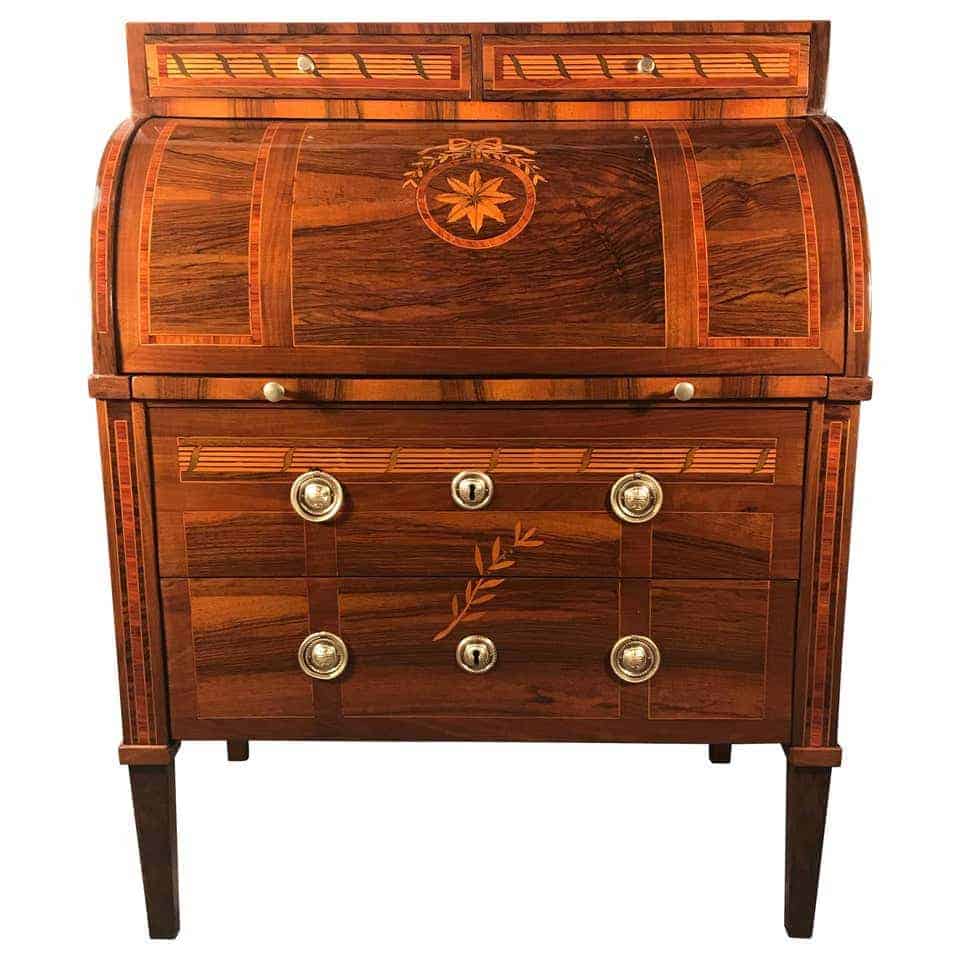
This elegant cylinder desk, dating circa 1780 and designed in Germany, features a stunning walnut veneer. Exquisite rosewood and maple intarsia run throughout the desk’s surface, and behind the cylinder top are five small drawers along with a larger open compartment. The writing top also features a walnut veneer.
This cylinder desk is in extremely good condition and has been French polished. It measures 36.62” H x 47.25” W x 22.84” D. The desk ships from Germany and its list price includes shipping to Boston.
Working Table, Louis XVI France 1780 – $4,900
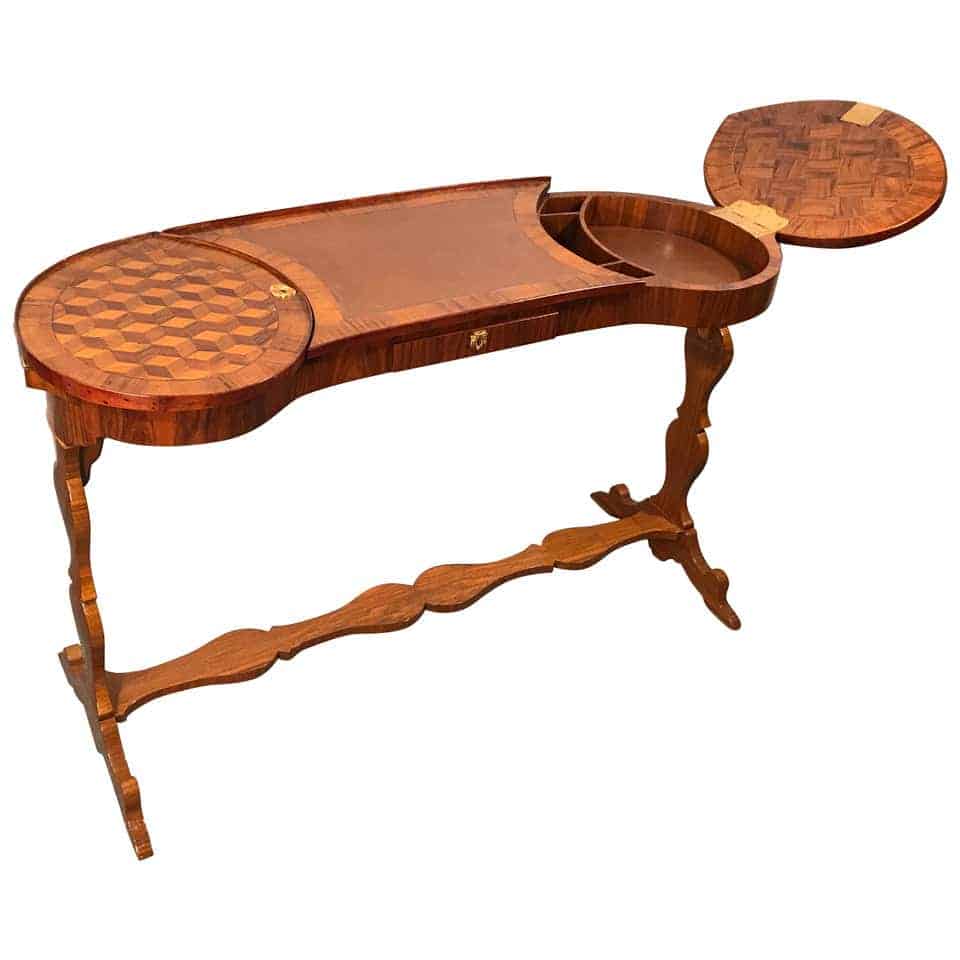
One of the most unique and alluring characteristics of this Louis XVI working table is the three-dimensional layered cube design on the surface. Walnut, maple, plum wood veneer, and marquetry decorate this kidney-shaped table. It features a leather top (replaced) along with a flap on either side. Finally, the compartments underneath the flaps work well as a space to store letters, pencils, other writing utensils, while a central drawer offers additional storage space.
This elegant working table is in great, original condition. It measures 26.97” H x 43.31” W x 15.75” D.
Kingwood Dresser, Louis XVI France 1780 – $6,900
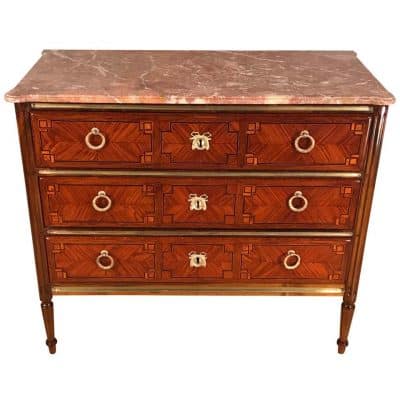
This beautiful antique Louis XVI dresser stands out for its elegant veneer, which is coupled with a geometric kingwood and tulipwood marquetry for an exquisite, distinguished appearance. The three-drawer commode is decorated with brass fittings and escutcheons, while brass fillets separate each drawer. The dresser’s canned round legs are sturdy walnut, while the original marble top tastefully accents the dresser’s outline.
This dresser is in very good condition and comes refinished. It measures 34.26” H x 39.38” W x 19.3” D. It ships from Germany and the list price includes shipping to Boston.
Antique Desk, Louis XVI France 1780 – $7,900
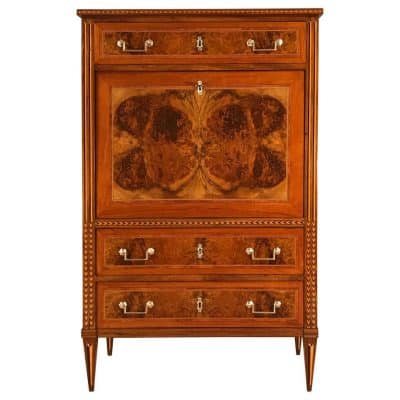
Dating back to 1780, this unique drop front desk originates in France. Here we have a standard example of Louis XVI furniture styles, with an elegant walnut root veneer on the exterior of the writing top, and walnut root veneer fields on each of the three drawers (one upper, two lower).
A beautiful cherry veneer frames walnut wood grain, while Louis XVI trademark geometric marquetry bands decorate the exquisite exterior. The inside of the writing top features six small drawers and four open compartments. Meanwhile, green leather covers the writing surface.
This drop front desk is in very good refinished and French polished condition. It measures 56.7” H x 36.23” W x 15.75” D. The desk ships from Germany and includes shipping costs to Boston.
Walnut Commode, Louis XVI Southern Germany 1780 – $6,500

This Louis XVI commode, hailing from Southern Germany in the 1780s, stands out for its different walnut veneer grains, separated by cherry marquetry flower decorations and pristine geometric bands. One of the focal points of this piece is beautiful marquetry depecting of two baskets hanging down from a robe, which decorates the sloped corners the commode.
This commode is in very good condition and still has its original vintage finish. It measures 33.47” H x 51.19” W x 23.63” D.
Armchairs, Louis XVI France 1800s – $3,000
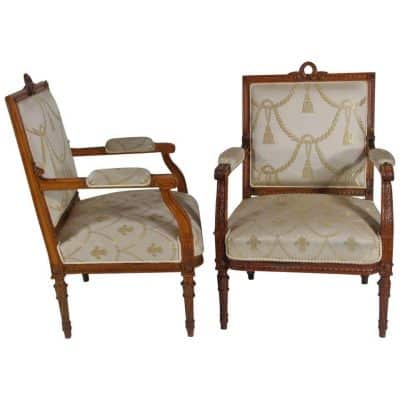
The pair of Louis XVI style armchairs are made of pear wood, with straight backs crowned with finely carved wreath decorations. The frame of the upholstered seat and back also features carved details, while the seat ends on round tapered baluster legs.
These elegant armchairs originally belonged to a salon suite composed of one settee and two chairs. The settee and the chairs are sold separately. Price for the set is $5,000 including the settee.
The chairs measure 39” H x 26” W x 22.83” D with a seat height of 17”. They ship from Germany and the list price includes shipping costs to Boston.
French Card Table, Louis XVI Strassburg 1780 – $4,000
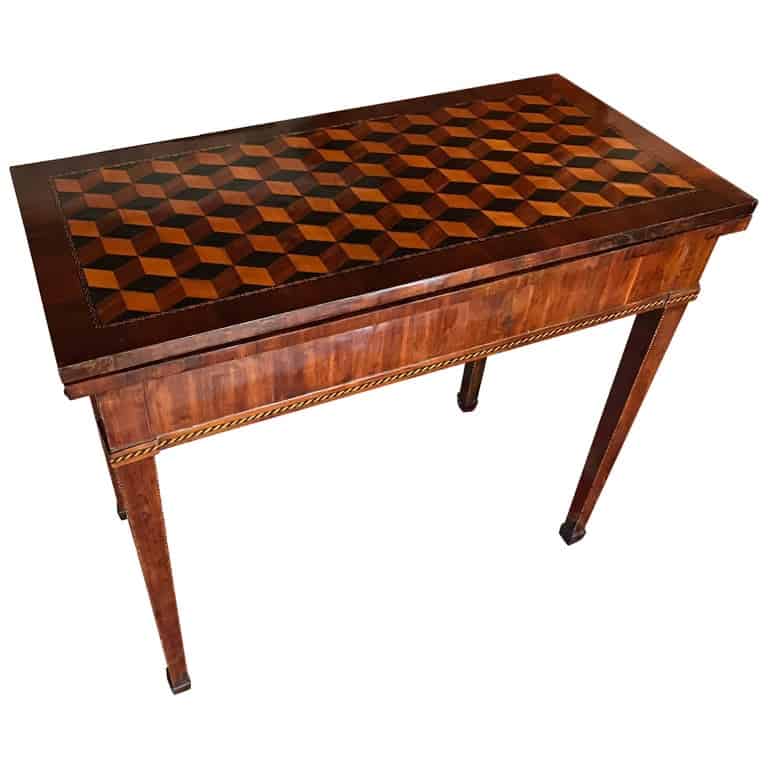
This unique French antique card table is decorated with a stunning wood block (also known as cube) marquetry on both the inside and outside of the top. The cabinetmaker used kingwood, satinwood and plum to create a trompe l’oeil effect here. To open the top, simply turn it and let it rest on the base of the table. All told, this is an extremely sturdy antique table.
The table is in very good condition with a nice original patina and the expected wear and tear of an 18th-century piece. It measures 29.14” H x 34.26” W x 17.13” D.
Vanity, Louis XVI Wuerzberg 1780 – $6,200
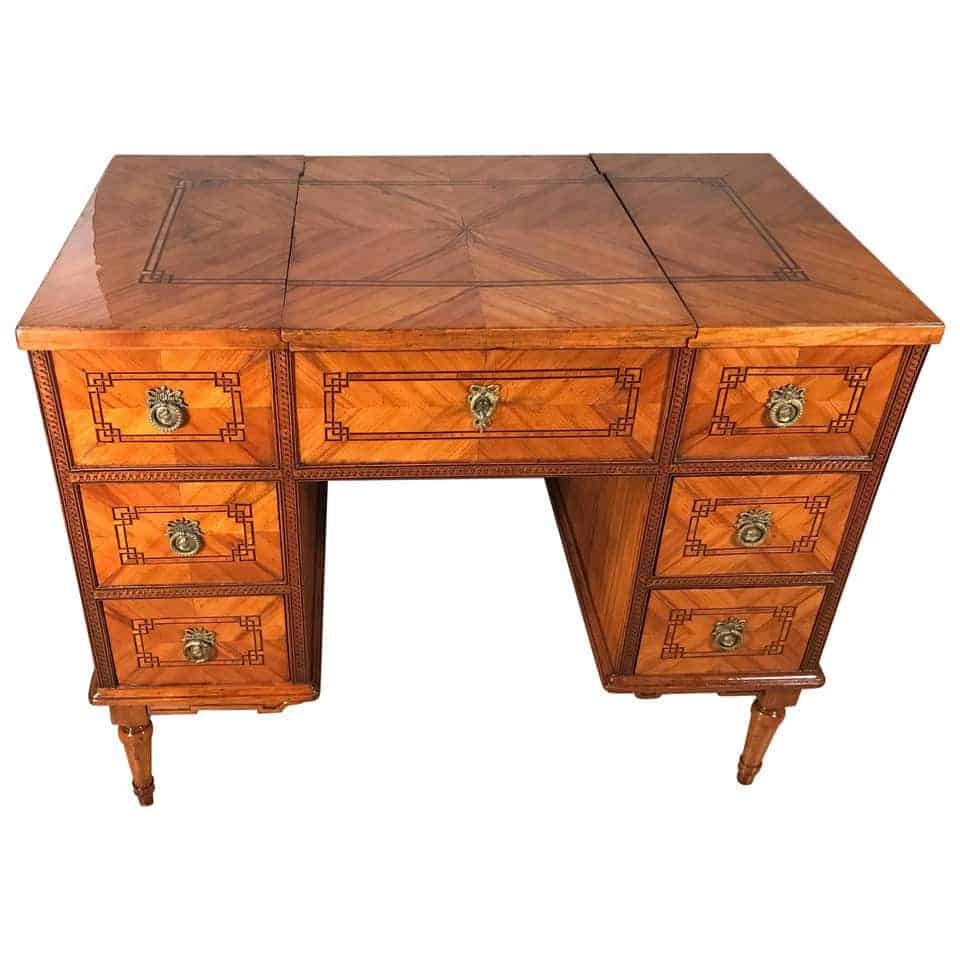
This exquisite original vanity (dressing table) was made in Southeast Germany, likely near the city of Wuerzburg around the year 1780. It features beautiful cherry veneer with marquetry details in elm. There are also flower-like inlays on the top and sides.
The middle opens with a flip-up mirror, while on each side there are two large compartments. Meanwhile, the original vintage paste paper decorates the interior.
This elegant vanity is in very good condition. The outside was carefully refinished and the inside is in its original vintage condition with the original paste paper.
It measures 30.52” H x 36.62” W x 20.67” D. It ships from Germany and the list prices includes shipping to Boston.
Decorating Tips
Due to the style’s geometric lines, you’ll find Louis XVI furniture styles are easy to combine with almost all contemporary interiors. That said, like any antique furniture style, you waste Louis XVI style pieces when you simply throw them into a room. Incorporating pieces from different periods and styles is critical if you want to add character, energy, and liveliness to any room.
Like we say with all our antiques, one thing to keep in mind is this: don’t use antiques to create rooms from the past. Create spaces that speak to modernity. Use the beauty of the antique to accent a space with a taste of the classic, Old World period. Mix it up, incorporating modern and vintage pieces together. This gives your antiques new life and allows you to present spaces envisioned in an organic and interesting way.
Opulence with Restraint
The Louis XVI period revels in opulence with restraint. Because we see a certain level of forbearance in the design of pieces from this style, such as fewer floral inlays and instead more solid wood veneers framed by gilded pieces… replicate that restraint in your interior design! Don’t overcrowd. Less is more.
Use gallery sofas, sometimes referred to as boudeuse (French for ‘sullen’), to allow visitors to appreciate your space from any angle without jamming with accessories. Incorporate greenery, gilt, and heavy fabrics to craft a warm, flowing ambiance. This plays off the geometric lines of the Louis XVI pieces.
Louis XVI championed neoclassical design as a less-extravagant alternative to the excesses of the rococo. When decorating with Louis XVI furniture styles in the 21st century, however, using a counterbalance to the straight lines that define the style is well-advised. Allow more exotic and fluid pieces to play off the geometric marquetry and linearity of the Louis XVI pieces in your space. This catalyzes a wholly organic ambiance.
More Alchemy Than Science
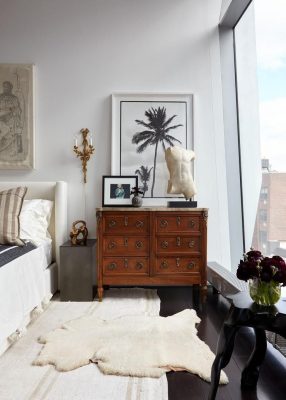 Where antique design is concerned, we like this quote from designer Maria Hademus: “I find that choosing the right antique is more alchemy than science.” What we mean by that is that it’s an art of intuition, understanding the aura of a space and finding the correct way to accentuate its positive qualities. It’s also important to remain targeted in your placement.
Where antique design is concerned, we like this quote from designer Maria Hademus: “I find that choosing the right antique is more alchemy than science.” What we mean by that is that it’s an art of intuition, understanding the aura of a space and finding the correct way to accentuate its positive qualities. It’s also important to remain targeted in your placement.
Antiques add an extra layer of personality and character to a room if placed properly. That said, be careful not to use too many pieces of a certain era in the same space. In that way, one can inadvertently create a historic interior. We don’t want a Louis XVI room (unless you are trying to create a museum). Place Louis XVI items precisely where they best accent the space.
Head to our shop to start your search, and reach out if you have any questions! We’re confident we can help you find the perfect antique piece for your space here at Styylish.

